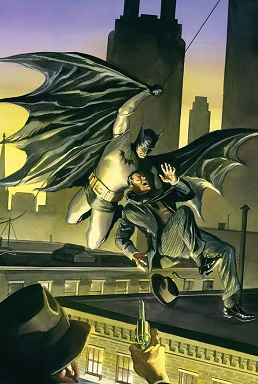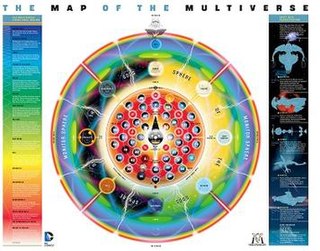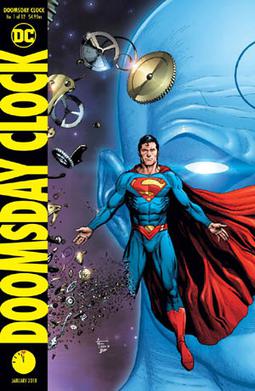In fiction, continuity is the consistency of the characteristics of people, plot, objects, and places seen by the audience over some period of time. It is relevant to many genres and forms of storytelling, especially if it is long-running.

"Crisis on Infinite Earths" is a 1985–1986 American comic book crossover storyline published by DC Comics. The series, written by Marv Wolfman and pencilled by George Pérez, was first serialized as a 12-issue limited series from April 1985 to March 1986. As the main piece of a crossover event, some plot elements were featured in tie-in issues of other publications. Since its initial publication, the series has been reprinted in various formats and editions.

The Justice League, or Justice League of America (JLA), is a group of superheroes appearing in American comic books published by DC Comics. The team first appeared in The Brave and the Bold #28. The team was conceived by writer Gardner Fox as a revival of the Justice Society of America, a similar team from DC Comics from the 1940s which had been pulled out of print due to a decline in sales.

The DC Universe (DCU) is the shared universe in which most stories in American comic book titles published by DC Comics take place. In context, the term "DC Universe" usually refers to the main DC continuity. It contains such well-known superheroes as Batman, Superman, Wonder Woman, the Flash, Green Lantern, Aquaman, Green Arrow, Shazam, Martian Manhunter, and Cyborg; as well as teams such as the Justice League, the Justice Society of America, the Suicide Squad, Doom Patrol, and the Teen Titans. It also contains well-known supervillains, including the Joker, Lex Luthor, the Cheetah, the Reverse-Flash, Sinestro, Black Manta, Deathstroke, Black Adam, Brainiac, and Darkseid.

The canon of a work of fiction is "the body of works taking place in a particular fictional world that are widely considered to be official or authoritative; [especially] those created by the original author or developer of the world". Canon is contrasted with, or used as the basis for, works of fan fiction and other derivative works.
Transformers is a media franchise produced by American toy company Hasbro and Japanese toy company Takara Tomy. It primarily follows the heroic Autobots and the villainous Decepticons, two alien robot factions at war that can transform into other forms, such as vehicles and animals. The franchise encompasses toys, animation, comic books, video games and films. As of 2011, it generated more than ¥2 trillion in revenue, making it one of the highest-grossing media franchises of all time.

Sandman Mystery Theatre was an ongoing comic book series published by Vertigo Comics, the mature-readers imprint of DC Comics. It ran for 70 issues, one annual, and a cross-over special between 1993 and 1999 and retells the adventures of the Sandman, a vigilante whose main weapon is a gun that fires sleeping gas, originally created by DC in the Golden Age of Comic Books. In a similar vein to Batman, the Sandman possesses little to no superhuman powers, though he has minor precognitive abilities through his prophetic dreams, and relies on his detective skills and inventions.

Amalgam Comics was a collaborative publishing imprint shared by DC Comics and Marvel Comics, in which the two comic book publishers merged their characters into new ones. These characters first appeared in a series of 12 one-shots which were published in April 1996 between Marvel Comics versus DC #3 and DC versus Marvel Comics #4, the last two issues of the DC vs. Marvel crossover event. A second set of 12 one-shots followed one year later in June 1997, but without the crossover event as a background. All 24 of these one-shots took place between the aforementioned issues of DC vs. Marvel Comics.
American comic book tropes are common elements and literary devices related to American comic books.

The Dreaming was a monthly comic series that ran for 60 issues and was revived in 2018. It is set in the same dimension of the DC universe as The Sandman and the stories occurred primarily within Dream's realm, The Dreaming, concentrating on characters who had played minor roles in The Sandman, including The Corinthian, Matthew the raven, Cain and Abel, Lucien the dream librarian, the faerie Nuala, Eve, and Mervyn Pumpkinhead. It also introduced a number of new characters, Echo and a new (white) dream raven, Tethys. After those characters were retconned the 2018 version of The Dreaming introduced new characters such as Hyperion Keeter, WAN, and the night hag, Dora. The 2020 spin-off / continuation, The Dreaming: Waking Hours introduced other new characters such as Linsy, Ruin, and most notably, Heather After, a direct descendant of Roderick Burgess. There were brief appearances by The Endless during the series, including cameos by Dream, Death, Destiny, and Desire.
The Man of Miracles is a fictional androgynous being featured in the Spawn comic book series.
In the course of the fictional story presented in the DC Comics event Infinite Crisis, several events in the fictional DC Universe's past were retroactively altered by either Superboy-Prime or the separation and re-merging of alternate Earths. Where not otherwise stated, this article deals only with changes known by the end of Infinite Crisis #7.

A parallel novel is an in-universe pastiche piece of literature written within, derived from, or taking place during the framework of another work of fiction by the same or another author with respect to continuity. Parallel novels or "reimagined classics" are works of fiction that "borrow a character and fill in his story, mirror an 'old' plot, or blend the characters of one book with those of another". These stories further the works of already well-known novels by focusing on a minor character and making them the major character. The revised stories may have the same setting and time frame and even the same characters.

The Batman of Earth-Two is an alternate version of the superhero Batman, who appears in American comic books published by DC Comics. The character was introduced after DC Comics created Earth-Two, a parallel world that was retroactively established as the home of characters whose adventures had been published in the Golden Age of comic books. This provided justification within the fictional world of Batman stories for DC Comics publishing Batman comic books that disregarded the character's Golden Age stories, as Batman had been presented as a single ongoing incarnation of the character since his earliest stories were published.
In analysis of works of fiction, revisionism denotes the retelling of a conventional or established narrative with significant variations which deliberately "revise" the view shown in the original work. For example, The Merry Adventures of Robin Hood revised the folklore tale of Robin Hood to depict Robin as less ambiguously heroic, influencing all subsequent modern portrayals. Many original works of fantasy appear to retell fairy tales in a revisionist manner.

Superhero fiction is a subgenre of speculative fiction examining the adventures, personalities and ethics of costumed crime fighters known as superheroes, who often possess superhuman powers and battle similarly powered criminals known as supervillains. The genre primarily falls between hard fantasy and soft science fiction in the spectrum of scientific realism. It is most commonly associated with American comic books, though it has expanded into other media through adaptations and original works.

In most of the DC Comics media, the Multiverse is a "cosmic construct" composed of the many fictional universes the stories of DC media take place in. The worlds in the multiverse share a space and fate in common, and its structure has changed several times in the history of DC Comics.
A shared universe or shared world is a fictional universe from a set of creative works where one or more writers independently contribute works that can stand alone but fits into the joint development of the storyline, characters, or world of the overall project. It is common in genres like science fiction. It differs from collaborative writing in which multiple artists are working together on the same work and from crossovers where the works and characters are independent except for a single meeting.

Doomsday Clock is a 2017–2019 superhero comic book limited series published by DC Comics, written by Geoff Johns with art by penciller Gary Frank and colorist Brad Anderson. The series concludes a tangential story established in the New 52 and DC Rebirth, and it is a sequel to the 1986–1987 graphic novel Watchmen by Alan Moore, Dave Gibbons and John Higgins, making it the first official crossover between Watchmen and the mainstream DC Universe.












